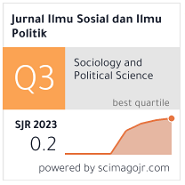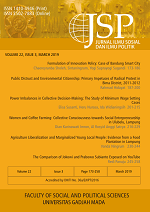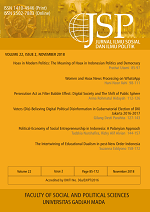What Do Opinion Leaders Share from the New Normal on Twitter?: A Qualitative Content Analysis
Fitrah Yusharyani Puluhulawa(1*), Rajiyem Rajiyem(2)
(1) Department of Communication Studies, Universitas Gadjah Mada, Indonesia
(2) Department of Communication Studies, Universitas Gadjah Mada, Indonesia
(*) Corresponding Author
Abstract
The question of what kind of content people share on social media is brought up by the COVID-19 pandemic and new normal policy. The government's well-coordinated campaign and the opposition's harsh comments are two of the reasons Indonesians actively utilize Twitter in relation to the new normal. This study intends to characterize and evaluate the presentation of new normal messages by opinion leaders on Twitter between May 16 and 29, 2020, since opinion leaders have historically been the network's active pioneers on a topic. The theories used for this study are self-presentation, opinion leaders, and the social media approach. The accounts of opinion leaders are determined through Drone Emprit's release of Top 100 New Normal Influencers, which then, generated six profiles: @haikal_hassan, @haris_azhar, @msaid_didu, @ridwankamil, @ismailfahmi, and @kurawa. The qualitative content analysis method was employed in this study with inductive reasoning. The findings revealed seven categories of new normal statements by opinion leaders, which corresponded to three key speech themes: 1) economic issues, 2) the implementation order of new normal life, and 3) negative sentiments. Additionally, we discovered that when opinion leaders create online personas, they do not aim to transcend the most fundamental parts of their backstage selves. Instead, they establish personas and personalities that are based on the same characters from the offline world. Meanwhile, this study suggests how the data might be useful for the Government, to consider the capacity of text-based platforms to help them learn about behaviors and needs during or even post-pandemic.
Keywords
Full Text:
PDFReferences
Alexandre, I., Jai-sung Yoo, J., & Murthy, D. (2021). Make Tweets Great Again: Who Are Opinion Leaders, and What Did They Tweet About Donald Trump? Social Science Computer Review, XX(X), 1-22. https://doi.org/10.1177/08944393211008859
Alkatiri, A. B. M., Nadiah, Z., & Nasution, A. N. S. (2020). Opini Publik Terhadap Penerapan New Normal Di Media Sosial Twitter. CoverAge: Journal of Strategic Communication, 11(1), 19–26. https://doi. org/10.35814/coverage.v11i1.1728
Baruah, C., & Borborah, P. (2021). A re-imagined community: Pandemic, media, and state. India Review, 20(2), 176–193. https://doi.or g/10.1080/14736489.2021.1895562
Baym, N. K. (2015). Social media and the struggle for society. Social Media+ Society, 1(1), 1-2. https://doi.org/10.1177/2056305115580477
Boaventura, B., Antunes, L. C., & Stanford, F. C. (2021). “New normal” routine: the impact of COVID-19 pandemic on chronodisrupture and its consequence on obesity. Chronobiology International, 38(8), 1083–1086. https://doi.org/10.1080/07420528.2021.1909612
Boellstorff, T. (2008). Coming of age in Second Life: An anthropologist explores the virtually human. Princeton University Press.
Bullingham, L., & Vasconcelos, A. C. (2013). “The presentation of self in the online world”: Goffman and the study of online identities. Journal of Information Science , 39 (1), 101–112. https://doi.org/10.1177/016555151247005
Chiang, J. K.-H., & Suen, H.-Y. (2015). Self-presentation and hiring recommendations in online communities: Lessons from LinkedIn. Computers in Human Behavior, 48, 516–524. https://doi.org/10.1016/j.chb.2015.02.017
Choi, M., Sang, Y., & Park, H. W. (2014). Exploring political discussions by Korean Twitter users: A look at opinion leadership and homophily phenomenon. Aslib Journal of Information Management. https://doi.org/10.1108/AJIM-11-2012-0089
Choi, S., & Park, H. W. (2014). An exploratory approach to a Twitter-based community centered on a political goal in South Korea: Who organized it, what they shared, and how they acted. New Media & Society, 16(1), 129–148. https://doi. org/10.1177/1461444813487956
Dalrymple, K. E., Shaw, B. R., & Brossard, D. (2013). Following the leader: Using opinion leaders in environmental strategic communication. Society & Natural Resources, 26(12), 1438–1453. https://doi.org/10.1080/08941920.2013.820812
Djafarova, E., & Trofimenko, O. (2019). ‘Instafamous’–credibility and self- presentation of micro-celebrities on social media. Information, Communication & Society, 22(10), 1432–1446. https://doi.org/10.1080/1369118X.2018.1438491
Drone Emprit. (2020). New normal: Most active countries who talk about ‘New normal’ in social media and how they made it. Drone Emprit Publications. https://pers. droneemprit.id/new-normal/
Dubois, E., & Gaffney, D. (2014). The multiple facets of influence: Identifying political influentials and opinion leaders on Twitter. American Behavioral Scientist, 58 (10), 1260–1277. https://doi.org/10.1177/0002764214527088
Dubois, E., Minaeian, S., Paquet-Labelle, A., & Beaudry, S. (2020). Who to trust on social media: How opinion leaders and seekers avoid disinformation and echo chambers. Social Media+ Society, 6(2), 1-13. https://doi.org/10.1177/2056305120913993
Fountaine, S. (2017). What’s not to like?: A qualitative study of young women politicians’ self-framing on Twitter. Journal of Public Relations Research, 29(5), 219–237. https://doi.org/10.1080/1062726X.2017.1388239
Ge-Stadnyk, J. (2021). Communicative functions of emoji sequences in the context of self- presentation: A comparative study of Weibo and Twitter users. Discourse & Communication, 15(4), 369–387. https://doi.org/10.1177/17504813211002038
Geurin-Eagleman, A. N., & Burch, L. M. (2016). Communicating via photographs: A gendered analysis of Olympic athletes’ visual self-presentation on Instagram. Sport Management Review, 19(2), 133–145. https://doi.org/10.1016/j.smr.2015.03.002
Goffman, E. (1959). The presentation of self in everyday life. Doubleday.
Gostin, L. O., Cohen, I. G., & Koplan, J. P. (2020). Universal masking in the United States: the role of mandates, health education, and the CDC. Jama, 324(9), 837–838. https://doi.org/10.1001/jama.2020.15271
Graham, T., Broersma, M., Hazelhoff, K., & Van’t Haar, G. (2013). Between broadcasting political messages and interacting with voters: The use of Twitter during the 2010 UK general election campaign. Information, Communication & Society, 16(5), 692–716. https://doi.org/10.1080/1369118X.2013.785581
Iivari, N., Sharma, S., & Ventä-Olkkonen, L. (2020). Dig it al t ransformat ion of everyday life – How COVID-19 pandemic transformed the basic education of the young generation and why information management research should care? International Journal of Information Management , 55 , 1-6. htt ps:/ / doi. org/10.1016/J.IJINFOMGT.2020.102183
Kaila, R. P., & Prasad, A. V. (2020). Informational flow on Twitter–Corona virus outbreak– topic modelling approach. International Journal of Advanced Research in Engineering and Technology (IJARET), 11(3), 128-134. http://www.iaeme.com/IJARET/index.asp
Katz, E., & Lazarsfeld, P. F. (1955). Personal influence: The part played by people in the flow of mass communications. Free Press.
Kim, J. W., & Chock, T. M. (2015). Body image 2.0: Associations between social grooming on Facebook and body image concerns. Computers in Human Behavior, 48, 331–339. https://doi.org/10.1016/j.chb.2015.01.009
Kompas.com. (2016). Dilaporkan Polisi, TNI, dan BNN ke Polri, Ini Tanggapan Haris Azhar. https://nasional.kompas.com/read/2016/08/03/07594491/dilaporkan.polisi.tni.dan.bnn.ke.polri.ini.tanggapan.haris.azhar?page=all
KontraS. (2021). Brutalitas Polisi Makin Menjadi di Tengah Pandemi. KontraS. https://kontras.org/wp-content/uploads/2021/06/Laporan-Bhayangkara-ke-75.pdf
Kurniawan, N. I., Prasetyo, W., Pamungkas, W. A., Ardianto, V., & Farid, M. (2020). Prioritas Pemulihan Ekonomi dan Kehidupan Sosial dalam Wacana ‘New Normal’: Analisis Pemberitaan Media Online di Indonesia Tentang New Normal ( Periode 1-30 Mei 2020 ) Fase Baru Penanganan Covid-19 Melalui Tatanan ‘New Normal’. https://polgov.fisipol.ugm.ac.id/riset/ prioritas-pemulihan-ekonomi-dan- kehidupan-sosial-dalam-wacana-new- normal-analisis-pemberitaan-media- online-di-indonesia-tentang-new-normal- periode-1-30-mei-2020
Kurniawan, R., & Apriliani, A. (2020). Analisis sentimen masyarakat terhadap virus corona berdasarkan opini dari Twitter berbasis web scraper. Jurnal INSTEK (Informatika Sains Dan Teknologi), 5(1), 67–75.
Kwon, K. H., Bang, C. C., Egnoto, M., & Raghav Rao, H. (2016). Social media rumors as improvised public opinion: semantic network analyses of twitter discourses during Korean saber rattling 2013. Asian Journal of Communication, 26(3), 201–222. https://doi.org/10.1080/01292986.2015.1130157
Larsson, A. O., & Moe, H. (2012). Studying political microblogging: Twitter users in the 2010 Swedish election campaign. New Media & Society, 14(5), 729–747. https://doi.org/10.1177/1461444811422894
Lu, Y., Jerath, K., & Singh, P. V. (2013). The emergence of opinion leaders in a networked online community: A dyadic model with time dynamics and a heuristic for fast estimation. Management Science, 59(8), 1783–1799. https://doi.org/10.1287/mnsc.1120.1685
Narbona, J. (2016). Digital leadership, twitter and Pope Francis. Church, Communication and Culture, 1(1), 90–109. https://doi.org/10.1080/23753234.2016.1181307
Nikjoo, A., Shabani, B., & Hernández-Lara, A. B. (2021). What do people share from quarantine? Current Issues in Tourism, 24(14), 1965–1969. https://doi.org/10.1080/13683500.2020.1808598
Olapegba, P. O., Iorfa, S. K., Kolawole, S. O., Oguntayo, R., Gandi, J. C., Ottu, I. F. A., & Ayandele, O. (2020). Survey data of COVID-19-related knowledge, risk perceptions and precautionary behavior among Nigerians. Data in Brief, 30. https:// doi.org/10.1016/j.dib.2020.105685
Ouirdi, M. El, El Ouirdi, A., Segers, J., & Henderickx, E. (2014). Social media conceptualization and taxonomy: A Lasswellian framework. Journal of Creative Communications, 9(2), 107–126. https://doi.org/10.1177/0973258614528608
Park, C. S. (2013). Does Twitter motivate involvement in politics? Tweeting, opinion leadership, and political engagement. Computers in Human Behavior, 29(4), 1641–1648. https://doi.org/10.1016/j.chb.2013.01.044
Park, C. S. (2019). Revisiting the two-step flow model on Twitter: Interconnection of self-identified South Korean Twitter opinion leadership, news consumption, news links, and news curation. Electronic News, 13(2), 63–77. https://doi. org/10.1177/1931243118809780
Puluhulawa, F. Y. (2021). Presentasi Pesan ‘New Normal’ di Media Sosial (Analisisis Isi Kualitatif Tema Pembicaraan dan Identitas Daring Opinion Leaders dalam Pesan New Normal Periode 16-29 Mei 2020 di Twitter) [Universitas Gadjah Mada]. http://etd.repository.ugm. ac.id/penelitian/detail/204364
Rastogi, S., & Bansal, D. (2021). Visualization of Twitter Sentiments on Kashmir Territorial Conflict. Cybernetics and Systems, 52(8), 642–669. https://doi.org/10.1080/01969722.2021.1949520
Rumata, V. M. (2017). ANALISIS ISI KUALITATIF TWITTER “# TaxAmnesty” DAN “# AmnestiPajak” A QUALITATIVE CONTENT ANALYSIS OF TWITTER “# TaxAmnesty” AND “# AmnestiPajak.” Jurnal PIKOM (Penelitian Komunikasi dan Pembangunan), 18(1), 1-18. https://doi. org/10.31346/jpkp.v18i1.840
Schäfer, M. S., & Taddicken, M. (2015). Opinion Leadership| Mediatized Opinion Leaders: New Patterns of Opinion Leadership in New Media Environments? International Journal of Communication, 9(1), 960-981. https://ijoc.org/index.php/ijoc/article/ view/2778
Schlenker, B. R. (1985). Identity and self- identification. In B. R. Schlenker (Ed.), The self and social life (pp. 65–99). McGraw-Hill.
Schreier, M. (2012). Qualitative Content Analysis in Practice. In SAGE Publications.
Schuster, J., Jörgens, H., & Kolleck, N. (2021). The rise of global policy networks in education: analyzing Twitter debates on inclusive education using social network analysis. Journal of Education Policy, 36(2), 211–231. https://doi.org/10.1080/02680939.2019.1664768
Song, S. Y., Cho, E., & Kim, Y.-K. (2017). Personality factors and flow affecting opinion leadership in social media. Personality and Individual Differences, 114, 16–23. https://doi.org/10.1016/j.paid.2017.03.058
Sparrow, R., Dartanto, T., & Hartwig, R. (2020). Indonesia Under the New Normal: Challenges and the Way Ahead. Bulletin of Indonesian Economic Studies, 56(3), 269–299. https://doi.org/10.1080/00074918.2020.1854079
Thornhill, R., & Fincher, C. L. (2014). The Parasite-Stress Theory of Values and Sociality: Infectious Disease, History and Human Values Worldwide. Springer.
Verweij, P., & Van Noort, E. (2014). Journalists’ twitter networks, public debates and relationships in South Africa. Digital Journalism, 2(1), 98–114. https://doi.org/10.1080/21670811.2013.850573
Waggoner, Z. (2009). My avatar, my self: Identity in video role-playing games. McFarland.
Walter, S ., & B rüggem ann, M . (2020). Opportunity makes opinion leaders: analyzing the role of first-hand information in opinion leadership in social media networks. Information Communication and Society, 23(2), 267–287. https://doi.org/10.1080/1369118X.2018.1500622
Wang, Z., & Ye, X. (2018). Social media analytics for natural disaster management. International Journal of Geographical Information Science, 32(1), 49–72. https://doi.org/10.1080/13658816.2017.1367003
Weeks, B. E., Ardèvol-Abreu, A., & Gil de Zúñiga, H. (2017). Online influence? Social media use, opinion leadership, and political persuasion. International Journal of Public Opinion Research, 29(2), 214–239. https://doi.org/10.1093/ijpor/edv050
Winter, S., Neubaum, G., Stieglitz, S., & Ross, B. (2021). # Opinionleaders: a comparison of self-reported and observable influence of Twitter users. Information, Communication & Society, 24(11), 1533–1550. https://doi.org/10.1080/1369118X.2019.1705374
Xu, Q., Yu, N., & Song, Y. (2 018 ). User engagement in public discourse on genetically modified organisms: The role of opinion leaders on social media. Science Communication, 40(6), 691–717. https://doi.org/10.1177/1075547018806526
Xu, W. W., Sang, Y., Blasiola, S., & Park, H. W. (2014). Predicting opinion leaders in Twitter activism networks: The case of the Wisconsin recall election. American Behavioral Scientist, 58(10), 1278–1293. https://doi.org/10.1177/0002764214527091
Article Metrics
Refbacks
- There are currently no refbacks.
Copyright (c) 2022 Jurnal Ilmu Sosial dan Ilmu Politik

This work is licensed under a Creative Commons Attribution-NonCommercial-NoDerivatives 4.0 International License.






















